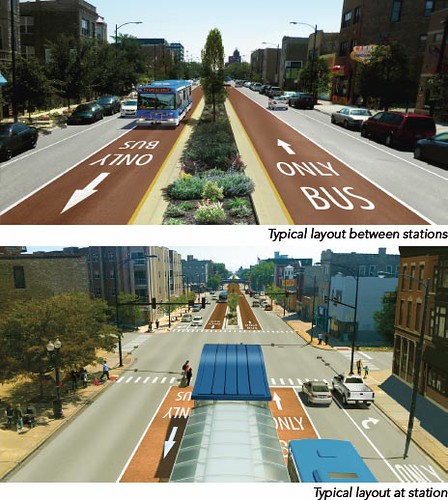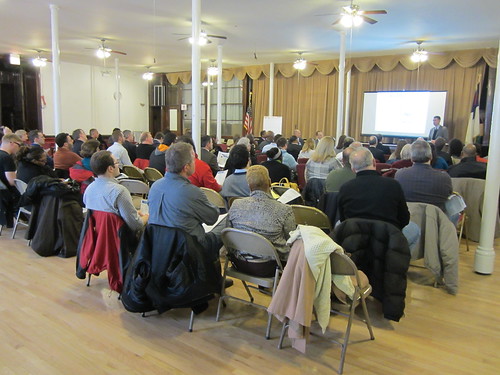It looks like some reporters are having trouble wrapping their heads around the city’s forward-thinking proposal to build Bus Rapid Transit on Western and/or Ashland. A DNAinfo.com write-up of a recent BRT meeting includes a few inaccurate statements and implies that the CTA and Chicago Department of Transportation are intent on removing large amounts parking on these streets to make way for bus lanes. In fact, the scenario that would yield the biggest improvement for bus riders and pedestrians would also retain almost all of the on-street parking. But since the wide range of potential BRT scenarios seems to be confusing the press as well as the general public, it's time for the agencies to choose the best option and move forward with it.
The article, “Business Owners Rip Proposal to Replace Parking With Express Bus Lanes,” states that the proposal “would create express bus lanes along Western and Ashland Avenues, in some cases cutting parking on the streets by more than half.” In reality the plan would create BRT corridors on either Western or Ashland, or possibly both. CTA and CDOT are considering four possible street configurations involving either center-running or curbside running buses, and travel lane removal or parking and median removal. Only two of these scenarios would remove parking from one side of the street; the other two would maintain 90 percent of parking (see all four scenarios in a chart).
The article states, “Two [design options] would focus on maintaining high levels of street parking by placing the express bus lanes in the middle of the street.” That's incorrect. One of the two center-running configurations would involve parking removal; the other wouldn’t. The reporter also writes, “The other options would reduce parking on one side of the street, but would also maintain left turn lanes for cars.” Actually, one of the scenarios with parking removal would also eliminate left turns, but the other would retain them.
DNA should have gotten its facts straight. But one way to reduce misunderstandings about the BRT proposal would be to simplify the options. At Thursday’s meeting, hosted by the newly formed Ashland Avenue-Western Avenue Coalition, a coalition of chambers of commerce and community development groups, business owners expressed concern that large-scale parking removal would hurt their bottom line. They didn’t seem to understand that half of the proposed BRT scenarios would retain the vast majority of parking spots. The fact is, the current proposal includes so many different possibilities – Western and/or Ashland, center-running or curbside, parking and medians removed or retained – it's easy for citizens to get confused.
After taking community input on the project last fall, CTA and CDOT are currently deciding which of the four possible street configurations they will announce as the “preferred alternative” later this winter. By now it's obvious which one they should choose. Months ago the Active Transportation Alliance endorsed the option with center-running BRT, travel lanes removed and parking retained because it’s the best choice for efficient bus service plus pedestrian safety and comfort. And it’s clear that neither business owners nor street safety advocates want to see parking and medians removed, which would hurt retail and force peds to cross a six-lane highway. That’s why CTA and CDOT should nip confusion about BRT in the bud by announcing center-running BRT with travel lane removal as their preferred alternative, as soon as possible.





